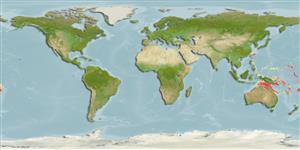>
Ophidiiformes (Cusk eels) >
Dinematichthyidae (Viviparous brotula)
Etymology: Diancistrus: Greek, di = two + Greek, agkistron = hook (Ref. 45335); mcgroutheri: Named for Mark Grouther, Sydney, Australia.
Eponymy: Mark Andrew McGrouther (d: 1958), whose honours degree was awarded by Sydney University (1980), worked at the Australian Museum, Sydney (1981–2018) and was Ichthyology Collection Manager until retirement (1987–2018). [...] (Ref. 128868), visit book page.
More on authors: Schwarzhans, Møller & Nielsen.
Environment: milieu / climate zone / depth range / distribution range
Écologie
marin récifal; profondeur 30 - 60 m (Ref. 57884). Subtropical
Western Pacific: northern Great Barrier Reef and along the southern part of Papua New Guinea.
Taille / Poids / Âge
Maturity: Lm ? range ? - ? cm
Max length : 4.7 cm SL mâle / non sexé; (Ref. 57884); 6.0 cm SL (female)
Description synthétique
Clés d'identification | Morphologie | Morphométrie
Rayons mous dorsaux (Total) : 73 - 76; Rayons mous anaux: 56 - 61; Vertèbres: 41. The species is distinguished by having the following characters: Vertebrae 11+30=41, dorsal fin rays 73-76, anal fin rays 56-61; small eyes (1.5-2.1% SL); outer pseudoclasper with small ear-lobe extension opening inwards; inner pseudoclasper free from outer pseudoclasper, with supporter, forming a sharp, forward-inclined thorn; narrow scale patch on cheek, absence of scales on operculum; head profile slender; otolith length to height ratio 2.0-2.2 (Ref. 57884).
Solitary inhabitant of coral reef crevices, cryptic (Ref 90102).
Life cycle and mating behavior
Maturité | Reproduction | Frai | Œufs | Fécondité | Larves
Schwarzhans, W., P.R. Møller and J.G. Nielsen, 2005. Review of the Dinematichthyini (Teleostei, Bythitidae) of the Indo-West-Pacific. Part I. Diancistrus and two new genera with 26 new species. The Beagle, Records of the Museum and Art Galleries of the Northern Territory 21:73-163. (Ref. 57884)
Statut dans la liste rouge de l'IUCN (Ref. 130435: Version 2024-1)
Menace pour l'homme
Harmless
Utilisations par l'homme
Pêcheries: sans intérêt
Outils
Articles particuliers
Télécharger en XML
Sources Internet
Estimates based on models
Preferred temperature (Ref.
123201): 26.2 - 27, mean 26.5 °C (based on 5 cells).
Phylogenetic diversity index (Ref.
82804): PD
50 = 0.5000 [Uniqueness, from 0.5 = low to 2.0 = high].
Bayesian length-weight: a=0.00389 (0.00180 - 0.00842), b=3.12 (2.94 - 3.30), in cm total length, based on all LWR estimates for this body shape (Ref.
93245).
Niveau trophique (Ref.
69278): 3.3 ±0.5 se; based on size and trophs of closest relatives
Fishing Vulnerability (Ref.
59153): Low vulnerability (10 of 100).
